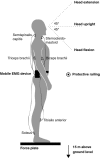Balance control and anti-gravity muscle activity during the experience of fear at heights
- PMID: 24744901
- PMCID: PMC3966255
- DOI: 10.1002/phy2.232
Balance control and anti-gravity muscle activity during the experience of fear at heights
Abstract
Fear of heights occurs when a visual stimulus causes the apprehension of losing balance and falling. A moderate form of visual height intolerance (vHI) affects about one third of the general population and has relevant consequences for the quality of life. A quantitative evaluation of balance mechanisms in persons susceptible to vHI during height exposure is missing. VHI-related changes in postural control were assessed by center-of-pressure displacements and electromyographic recordings of selected leg, arm, and neck muscles in 16 subjects with vHI while standing at heights on an emergency balcony versus standing in the laboratory at ground level. Characteristics of open- and closed-loop postural control were analyzed. Body sway and muscle activity parameters were correlated with the subjective estimates of fear at heights. During height exposure, (1) open-loop control was disturbed by a higher diffusion activity (P < 0.001) and (2) the sensory feedback threshold for closed-loop control was lowered (P < 0.010). Altered postural control was predominantly associated with increased co-contraction of leg muscles. Body sway and leg and neck muscle co-contraction correlated with the severity of subjective anxiety (P < 0.050). Alterations in postural control diminished if there were nearby stationary contrasts in the visual surrounding or if subjects stood with eyes closed. The performance of a cognitive dual task also improved impaired balance. Visual heights have two behavioral effects in vHI subjects: A change occurs in (1) open- and closed-loop postural control strategy and (2) co-contraction of anti-gravity leg and neck muscles, both of which depend on the severity of evoked fear at heights.
Keywords: Balance control; fear of heights; muscle activity; muscle co‐contraction; visual height intolerance.
Figures




Similar articles
-
Quantification of gait changes in subjects with visual height intolerance when exposed to heights.Front Hum Neurosci. 2014 Dec 4;8:963. doi: 10.3389/fnhum.2014.00963. eCollection 2014. Front Hum Neurosci. 2014. PMID: 25538595 Free PMC article.
-
Distracting attention in phobic postural vertigo normalizes leg muscle activity and balance.Neurology. 2017 Jan 17;88(3):284-288. doi: 10.1212/WNL.0000000000003516. Epub 2016 Dec 14. Neurology. 2017. PMID: 27974646
-
Acrophobia impairs visual exploration and balance during standing and walking.Ann N Y Acad Sci. 2015 Apr;1343:37-48. doi: 10.1111/nyas.12692. Epub 2015 Feb 26. Ann N Y Acad Sci. 2015. PMID: 25722015 Review.
-
Fear of heights shapes postural responses to vibration-induced balance perturbation at virtual height.Front Hum Neurosci. 2023 Sep 12;17:1229484. doi: 10.3389/fnhum.2023.1229484. eCollection 2023. Front Hum Neurosci. 2023. PMID: 37771346 Free PMC article.
-
Acrophobia and visual height intolerance: advances in epidemiology and mechanisms.J Neurol. 2020 Dec;267(Suppl 1):231-240. doi: 10.1007/s00415-020-09805-4. Epub 2020 May 22. J Neurol. 2020. PMID: 32444982 Free PMC article. Review.
Cited by
-
Voluntary muscle coactivation in quiet standing elicits reciprocal rather than coactive agonist-antagonist control of reactive balance.J Neurophysiol. 2023 Jun 1;129(6):1378-1388. doi: 10.1152/jn.00458.2022. Epub 2023 May 10. J Neurophysiol. 2023. PMID: 37162064 Free PMC article.
-
Cortical alterations in phobic postural vertigo - a multimodal imaging approach.Ann Clin Transl Neurol. 2018 May 14;5(6):717-729. doi: 10.1002/acn3.570. eCollection 2018 Jun. Ann Clin Transl Neurol. 2018. PMID: 29928655 Free PMC article.
-
Brain Correlates of Persistent Postural-Perceptual Dizziness: A Review of Neuroimaging Studies.J Clin Med. 2021 Sep 21;10(18):4274. doi: 10.3390/jcm10184274. J Clin Med. 2021. PMID: 34575385 Free PMC article. Review.
-
New Insights on Emotional Contributions to Human Postural Control.Front Neurol. 2018 Sep 21;9:789. doi: 10.3389/fneur.2018.00789. eCollection 2018. Front Neurol. 2018. PMID: 30298048 Free PMC article.
-
Susceptibility to Fear of Heights in Bilateral Vestibulopathy and Other Disorders of Vertigo and Balance.Front Neurol. 2018 Jun 6;9:406. doi: 10.3389/fneur.2018.00406. eCollection 2018. Front Neurol. 2018. PMID: 29928252 Free PMC article.
References
-
- Adkin A. L., Frank J. S., Carpenter M. G., Peysar G. W. 2002. Fear of falling modifies anticipatory postural control. Exp. Brain Res.; 143:160-170 - PubMed
-
- Alpers G. W., Adolph D. 2008. Exposure to heights in a theme park: fear, dizziness, and body sway. J. Anxiety Disord.; 22:591-601 - PubMed
-
- APA Diagnostic and statistical manual of mental disorders: DSM‐5. 20135th edWashington, DC: American Psychiatric Publishing; 2013
-
- Benjamini Y., Hochberg Y. 1995. Controlling the false discovery rate: a practical and powerful approach to multiple testing. J. R. Stat. Soc. Series B Methodol.; 57:289-300
LinkOut - more resources
Full Text Sources
Other Literature Sources

